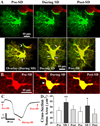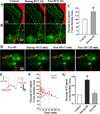Persistent astroglial swelling accompanies rapid reversible dendritic injury during stroke-induced spreading depolarizations
- PMID: 22821441
- PMCID: PMC3435464
- DOI: 10.1002/glia.22390
Persistent astroglial swelling accompanies rapid reversible dendritic injury during stroke-induced spreading depolarizations
Abstract
Spreading depolarizations are a key event in the pathophysiology of stroke, resulting in rapid dendritic beading, which represents acute damage to synaptic circuitry. The impact of spreading depolarizations on the real-time injury of astrocytes during ischemia is less clear. We used simultaneous in vivo 2-photon imaging and electrophysiological recordings in adult mouse somatosensory cortex to examine spreading depolarization-induced astroglial structural changes concurrently with signs of neuronal injury in the early periods of focal and global ischemia. Astrocytes in the metabolically compromised ischemic penumbra-like area showed a long lasting swelling response to spontaneous spreading depolarizations despite rapid dendritic recovery in a photothrombotic occlusion model of focal stroke. Astroglial swelling was often facilitated by recurrent depolarizations and the magnitude of swelling strongly correlated with the total duration of depolarization. In contrast, spreading depolarization-induced astroglial swelling was transient in normoxic healthy tissue. In a model of transient global ischemia, the occurrence of a single spreading depolarization elicited by a bilateral common carotid artery occlusion coincided with astroglial swelling alongside dendritic beading. With immediate reperfusion, dendritic beading subsides. Astroglial swelling was either transient during short ischemic periods distinguished by a short-lasting spreading depolarization, or persistent during severe ischemia characterized by a long-lasting depolarization with the ultraslow negative voltage component. We propose that persistent astroglial swelling is initiated and exacerbated during spreading depolarization in brain tissue with moderate to severe energy deficits, disrupting astroglial maintenance of normal homeostatic function thus contributing to the negative outcome of ischemic stroke as astrocytes fail to provide neuronal support.
Copyright © 2012 Wiley Periodicals, Inc.
Figures





Similar articles
-
Dibucaine mitigates spreading depolarization in human neocortical slices and prevents acute dendritic injury in the ischemic rodent neocortex.PLoS One. 2011;6(7):e22351. doi: 10.1371/journal.pone.0022351. Epub 2011 Jul 15. PLoS One. 2011. PMID: 21789251 Free PMC article.
-
Evolution of neuronal and astroglial disruption in the peri-contusional cortex of mice revealed by in vivo two-photon imaging.Brain. 2013 May;136(Pt 5):1446-61. doi: 10.1093/brain/awt026. Epub 2013 Mar 6. Brain. 2013. PMID: 23466395 Free PMC article.
-
Recurrent spontaneous spreading depolarizations facilitate acute dendritic injury in the ischemic penumbra.J Neurosci. 2010 Jul 21;30(29):9859-68. doi: 10.1523/JNEUROSCI.1917-10.2010. J Neurosci. 2010. PMID: 20660268 Free PMC article.
-
Recording, analysis, and interpretation of spreading depolarizations in neurointensive care: Review and recommendations of the COSBID research group.J Cereb Blood Flow Metab. 2017 May;37(5):1595-1625. doi: 10.1177/0271678X16654496. Epub 2016 Jan 1. J Cereb Blood Flow Metab. 2017. PMID: 27317657 Free PMC article. Review.
-
Direct electrophysiological evidence that spreading depolarization-induced spreading depression is the pathophysiological correlate of the migraine aura and a review of the spreading depolarization continuum of acute neuronal mass injury.Geroscience. 2020 Feb;42(1):57-80. doi: 10.1007/s11357-019-00142-7. Epub 2019 Dec 9. Geroscience. 2020. PMID: 31820363 Free PMC article. Review.
Cited by
-
Molecular mechanisms of brain water transport.Nat Rev Neurosci. 2021 Jun;22(6):326-344. doi: 10.1038/s41583-021-00454-8. Epub 2021 Apr 12. Nat Rev Neurosci. 2021. PMID: 33846637 Review.
-
Ketamine reduces deleterious consequences of spreading depolarizations.Exp Neurol. 2018 Jul;305:121-128. doi: 10.1016/j.expneurol.2018.04.007. Epub 2018 Apr 10. Exp Neurol. 2018. PMID: 29653188 Free PMC article.
-
Excitotoxicity and Metabolic Crisis Are Associated with Spreading Depolarizations in Severe Traumatic Brain Injury Patients.J Neurotrauma. 2016 Oct 1;33(19):1775-1783. doi: 10.1089/neu.2015.4226. Epub 2016 Mar 18. J Neurotrauma. 2016. PMID: 26586606 Free PMC article.
-
Hippocampal and Cortical Pyramidal Neurons Swell in Parallel with Astrocytes during Acute Hypoosmolar Stress.Front Cell Neurosci. 2017 Sep 20;11:275. doi: 10.3389/fncel.2017.00275. eCollection 2017. Front Cell Neurosci. 2017. PMID: 28979186 Free PMC article.
-
Spreading depolarization causes reversible neuronal mitochondria fragmentation and swelling in healthy, normally perfused neocortex.J Cereb Blood Flow Metab. 2024 Dec;44(12):1561-1579. doi: 10.1177/0271678X241257887. Epub 2024 Jul 25. J Cereb Blood Flow Metab. 2024. PMID: 39053498 Free PMC article.
References
-
- Aitken PG, Tombaugh GC, Turner DA, Somjen GG. Similar propagation of SD and hypoxic SD-like depolarization in rat hippocampus recorded optically and electrically. J Neurophysiol. 1998;80:1514–1521. - PubMed
-
- Amiry-Moghaddam M, Ottersen OP. The molecular basis of water transport in the brain. Nat Rev Neurosci. 2003;4:991–1001. - PubMed
-
- Andrew RD, Labron MW, Boehnke SE, Carnduff L, Kirov SA. Physiological evidence that pyramidal neurons lack functional water channels. Cereb Cortex. 2007;17:787–802. - PubMed
-
- Araque A, Parpura V, Sanzgiri RP, Haydon PG. Tripartite synapses: glia, the unacknowledged partner. Trends Neurosci. 1999;22:208–215. - PubMed
Publication types
MeSH terms
Grants and funding
LinkOut - more resources
Full Text Sources
Medical

